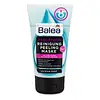What's inside
What's inside
 Key Ingredients
Key Ingredients

 Benefits
Benefits

 Concerns
Concerns

 Ingredients Side-by-side
Ingredients Side-by-side

Water
Skin ConditioningKaolin
AbrasiveGlycerin
HumectantCetyl Alcohol
EmollientGlyceryl Stearate Se
EmulsifyingEthylhexyl Stearate
EmollientHelianthus Annuus Hybrid Oil
EmollientHydrogenated Castor Oil
EmollientPumice
AbrasiveBentonite
AbsorbentSodium Cetearyl Sulfate
CleansingSalicylic Acid
MaskingZinc PCA
HumectantAlcohol Denat.
AntimicrobialXanthan Gum
EmulsifyingTocopherol
AntioxidantParfum
MaskingPhenoxyethanol
PreservativeEthylhexylglycerin
Skin ConditioningLinalool
PerfumingLimonene
PerfumingBenzyl Alcohol
PerfumingCitronellol
PerfumingGeraniol
PerfumingAlpha-Isomethyl Ionone
PerfumingWater, Kaolin, Glycerin, Cetyl Alcohol, Glyceryl Stearate Se, Ethylhexyl Stearate, Helianthus Annuus Hybrid Oil, Hydrogenated Castor Oil, Pumice, Bentonite, Sodium Cetearyl Sulfate, Salicylic Acid, Zinc PCA, Alcohol Denat., Xanthan Gum, Tocopherol, Parfum, Phenoxyethanol, Ethylhexylglycerin, Linalool, Limonene, Benzyl Alcohol, Citronellol, Geraniol, Alpha-Isomethyl Ionone
Salicylic Acid 2%
MaskingWater
Skin ConditioningSodium C14-16 Olefin Sulfonate
CleansingGlycerin
HumectantCocamidopropyl Betaine
CleansingMicrocrystalline Cellulose
AbsorbentAcrylates Copolymer
Parfum
MaskingPolysorbate 20
EmulsifyingSodium Hydroxide
BufferingC12-15 Alkyl Lactate
EmollientBenzalkonium Chloride
AntimicrobialPolyquaternium-7
Disodium EDTA
Menthol
MaskingCocamidopropyl Pg-Dimonium Chloride Phosphate
Sodium Benzotriazolyl Butylphenol Sulfonate
UV AbsorberCarrageenan
Agar
MaskingAscorbyl Palmitate
AntioxidantIron Oxides
CI 19140
Cosmetic ColorantCI 16035
Cosmetic ColorantMica
Cosmetic ColorantCI 73360
Cosmetic ColorantTitanium Dioxide
Cosmetic ColorantSalicylic Acid 2%, Water, Sodium C14-16 Olefin Sulfonate, Glycerin, Cocamidopropyl Betaine, Microcrystalline Cellulose, Acrylates Copolymer, Parfum, Polysorbate 20, Sodium Hydroxide, C12-15 Alkyl Lactate, Benzalkonium Chloride, Polyquaternium-7, Disodium EDTA, Menthol, Cocamidopropyl Pg-Dimonium Chloride Phosphate, Sodium Benzotriazolyl Butylphenol Sulfonate, Carrageenan, Agar, Ascorbyl Palmitate, Iron Oxides, CI 19140, CI 16035, Mica, CI 73360, Titanium Dioxide
Ingredients Explained
These ingredients are found in both products.
Ingredients higher up in an ingredient list are typically present in a larger amount.
Glycerin is already naturally found in your skin. It helps moisturize and protect your skin.
A study from 2016 found glycerin to be more effective as a humectant than AHAs and hyaluronic acid.
As a humectant, it helps the skin stay hydrated by pulling moisture to your skin. The low molecular weight of glycerin allows it to pull moisture into the deeper layers of your skin.
Hydrated skin improves your skin barrier; Your skin barrier helps protect against irritants and bacteria.
Glycerin has also been found to have antimicrobial and antiviral properties. Due to these properties, glycerin is often used in wound and burn treatments.
In cosmetics, glycerin is usually derived from plants such as soybean or palm. However, it can also be sourced from animals, such as tallow or animal fat.
This ingredient is organic, colorless, odorless, and non-toxic.
Glycerin is the name for this ingredient in American English. British English uses Glycerol/Glycerine.
Learn more about GlycerinParfum is a catch-all term for an ingredient or more that is used to give a scent to products.
Also called "fragrance", this ingredient can be a blend of hundreds of chemicals or plant oils. This means every product with "fragrance" or "parfum" in the ingredients list is a different mixture.
For instance, Habanolide is a proprietary trade name for a specific aroma chemical. When used as a fragrance ingredient in cosmetics, most aroma chemicals fall under the broad labeling category of “FRAGRANCE” or “PARFUM” according to EU and US regulations.
The term 'parfum' or 'fragrance' is not regulated in many countries. In many cases, it is up to the brand to define this term.
For instance, many brands choose to label themselves as "fragrance-free" because they are not using synthetic fragrances. However, their products may still contain ingredients such as essential oils that are considered a fragrance by INCI standards.
One example is Calendula flower extract. Calendula is an essential oil that still imparts a scent or 'fragrance'.
Depending on the blend, the ingredients in the mixture can cause allergies and sensitivities on the skin. Some ingredients that are known EU allergens include linalool and citronellol.
Parfum can also be used to mask or cover an unpleasant scent.
The bottom line is: not all fragrances/parfum/ingredients are created equally. If you are worried about fragrances, we recommend taking a closer look at an ingredient. And of course, we always recommend speaking with a professional.
Learn more about ParfumSalicylic Acid (also known as beta hydroxy acid or BHA) is a well-known ingredient for treating skin that struggles with acne and clogged pores. It exfoliates both the skin's surface and deep within the pores to help clear out buildup, control oil, and reduce inflammation.
Unlike AHAs (alpha hydroxy acids), salicylic acid is oil-soluble. This allows it to penetrate into pores which makes it especially effective for treating blackheads and preventing future breakouts.
Salicylic acid is also known for its soothing properties. It has a similar structure to aspirin and can calm inflamed or irritated skin, making it a good option for acne-prone skin that is also sensitive.
Concentrations of 0.5-2% are recognized by the U.S. FDA as an over-the-counter topical acne product.
It can cause irritation and/or dryness if one's skin already has a compromised moisture barrier, so it's best to focus on repairing that before introducing this ingredient into your routine.
While salicylic acid does not increase sun sensitivity, it’s still important to wear sunscreen daily to protect your skin.
If you are looking for the ingredient called BHA or Butylated Hydroxyanisole, click here.
Learn more about Salicylic AcidWater. It's the most common cosmetic ingredient of all. You'll usually see it at the top of ingredient lists, meaning that it makes up the largest part of the product.
So why is it so popular? Water most often acts as a solvent - this means that it helps dissolve other ingredients into the formulation.
You'll also recognize water as that liquid we all need to stay alive. If you see this, drink a glass of water. Stay hydrated!
Learn more about Water